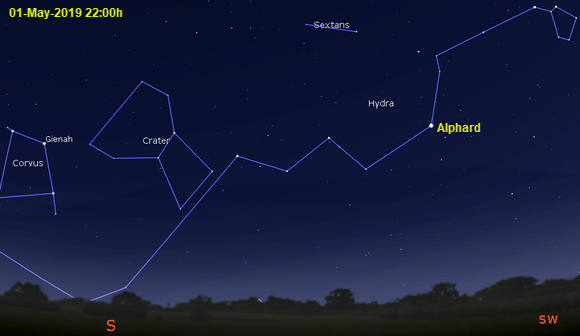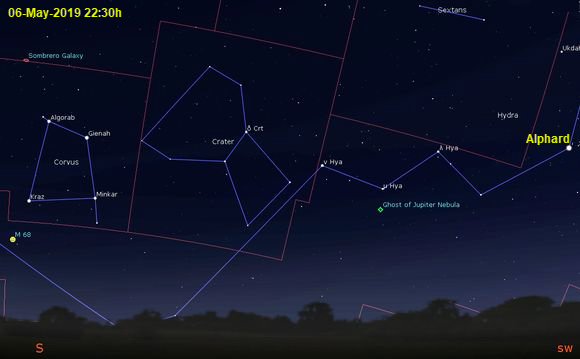Continuing the tour of stellar objects crossing the meridian line this month: Alphard: the most northerly star of the River constellation Eridanus.
Star: Alphard – alpha Hydrae, Hydra and the Crow and Cup
Easily visible unassisted.
Chief star in Hydra - the traditional name Alphard is from the Arabic (al-fard), "The Solitary One", no doubt because there are no other bright stars in Alphard’s immediate vicinity. The European astronomer Tycho Brahe dubbed it Cor Hydrae, Latin for 'the heart of Hydra'. At magnitude +1.8 Alphard is a ‘bright’ second magnitude star and lies approximately 177 light years away.
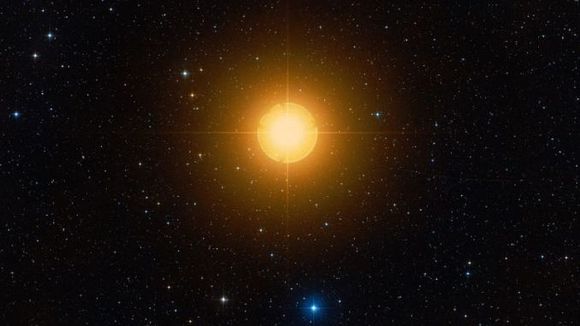
Alphard (Alpha Hydrae) 'The Lonely One'
Probably starting out as a mid B-class star of around three times the mass of the Sun, Alphard, although only around 420-430 million years old, has already evolved away from the main sequence to become a giant star with a spectral classification of K3 and luminosity class of between II and III, equating to a surface temp of 4,300K and approximately 1,000 times our sun’s luminosity. According to theories on stellar evolution, Alphard is already fusing helium into carbon and oxygen deep in its core. Alphard has now swollen to over 55 times the Sun’s radius, which places it among the top three biggest stars of its type, and perhaps only Betelgeuse and R Doradus are larger.
Alphard's spectrum shows a mild excess of barium, an element that is normally produced by the s-process of nucleosynthesis. Typically a barium star belongs to a binary system and the anomalies in abundances are explained by mass transfer from a companion white dwarf star. This arrangement almost always explains the presence of abundances through the mechanism of mass transfer from the white dwarf to the normal star, but in Alphard’s case, no companion star of any type has been identified.
Alphard is also of scientific interest as an object for the study of asteroseismological events. Precise measurements of variations in Alphard’s radial velocities and spectral lines have revealed multi-periodic oscillations, with periods that range from a few hours to several days. These short-term oscillations are thought to be similar to those pulsations that occur on the Sun, but exact reasons for these correlations between the variations in the stars’ spectral line and radial velocity remain to be discovered.
Location
You can locate Alphard to the SW as darkness falls in early May, below and slightly ahead of bright Regulus in Leo.
Hydra, the Water Serpent, is the largest constellation in the heavens, extending from below Cancer in the WSW, to beneath Virgo down in the ESE. Indeed it is well after 23:00h before the entire constellation is visible. In Greek mythology, Leo, Cancer and Hydra are all associated with Hera, Queen of the gods. Both Leo and Hydra were raised as pets by Hera.
Leo’s coat was said to be impervious to fire and metal weapons, whilst the multi-headed snake was empowered with the ability to re-grow its heads; should one be cut off. In the first of his twelve labours, Hercules, whom Hera despised, was tasked with slaying the lion beast ravaging the region of Nemea. He duly trapped the beast in a cave and clubbed it to death. In honour of this deed, Zeus placed the lion in the heavens.
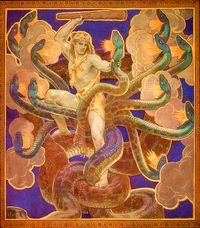 Decidedly miffed by the loss of her pet, Hera then pitted Hercules against the multi headed Hydra, which he overcame by using flaming arrows to cauterise the neck-stumps thus stopping the heads from regenerating. Hera; who saw the snake was in trouble, sent a giant crab (Cancer) to assist Hydra. In the ensuing battle Hercules also crushed the giant crustacean. A distraught Hera then placed both monstrous creatures in the heavens.
Decidedly miffed by the loss of her pet, Hera then pitted Hercules against the multi headed Hydra, which he overcame by using flaming arrows to cauterise the neck-stumps thus stopping the heads from regenerating. Hera; who saw the snake was in trouble, sent a giant crab (Cancer) to assist Hydra. In the ensuing battle Hercules also crushed the giant crustacean. A distraught Hera then placed both monstrous creatures in the heavens.
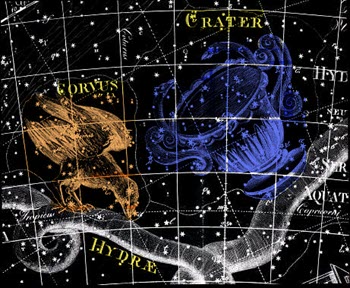 Toward the tail of Hydra, two small but original constellations rest on snakes body; Corvus the Crow and Crater the Cup. Corvus and Crater are linked by one legend in which Apollo sent his pet white crow to fetch a cup of water. The bird flew off with the cup in his talons, but tarried, waiting for the fruit of a fig tree to ripen. On his return Corvus tried to convince Apollo that Hydra the water snake had delayed him. Apollo did not believe the bird and in a rage turned the crow black, dispatching him to the sky close to Crater, which is just out of the thirsty bird’s reach.
Toward the tail of Hydra, two small but original constellations rest on snakes body; Corvus the Crow and Crater the Cup. Corvus and Crater are linked by one legend in which Apollo sent his pet white crow to fetch a cup of water. The bird flew off with the cup in his talons, but tarried, waiting for the fruit of a fig tree to ripen. On his return Corvus tried to convince Apollo that Hydra the water snake had delayed him. Apollo did not believe the bird and in a rage turned the crow black, dispatching him to the sky close to Crater, which is just out of the thirsty bird’s reach.
The outline of Crater is rather faint and difficult to trace in light polluted skies, but from a dark sky location the pattern does somewhat resemble the outline of a cup or goblet. The stars of Corvus are a little more prominent, but are certainly not arranged in the shape of a crow. Instead the grouping is quadrilateral in nature, one which mariners and astronomers sometimes refer to as ‘Spica’s Spanker’, a spanker being a type of sail the outline of which matches Corvus almost exactly. Counting clockwise from top left the stars are Algorab, Gienah, Minkar and Kraz.
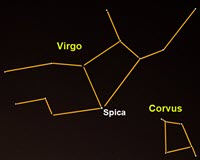 Spica is the bright first magnitude star in Virgo located to the upper left of the crow. There is one messier object (M68) in Hydra, a globular cluster, located below Corvus. Algorab and Kraz point down to it, one third their separation passed Kraz. The other object of note is the planetary nebula NGC 3242, the ‘ghost of Jupiter’, which can be located below right of Crater.
Spica is the bright first magnitude star in Virgo located to the upper left of the crow. There is one messier object (M68) in Hydra, a globular cluster, located below Corvus. Algorab and Kraz point down to it, one third their separation passed Kraz. The other object of note is the planetary nebula NGC 3242, the ‘ghost of Jupiter’, which can be located below right of Crater.
- Log in to post comments

